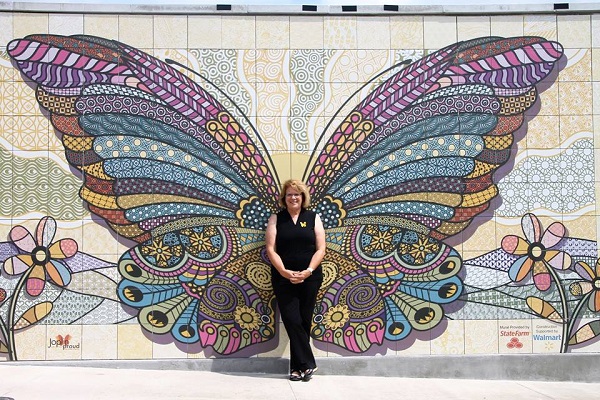Five Years Later: Rebuilding Joplin

Jane Cage poses at the dedication of the new butterfly mural at Mercy Park in Joplin, MO. Anyone can become a butterfly – a symbol that has such meaning for Joplin, 2016
Three years ago – related to post-Joplin activities – I had the pleasure of virtually meeting Jane Cage. Jane served as the volunteer chairman of the Citizens Advisory Recovery Team (CART) formed after the May 2011 Joplin tornado – one of the most destructive tornadoes in U.S. history. As the CART leader, she led the group in listening to citizens about their vision for a recovered Joplin. The resulting report became the long-term recovery plan for Joplin. Today Jane acts as a community liaison for many groups and continues to participate in recovery activities.
This past May, The Joplin Disaster Recovery Summit convened for a unique disaster recovery summit told entirely through the lens and experience of community leaders and elected officials.
This was a one-of-a-kind opportunity to hear lessons learned from communities across the Midwest that experienced some of the worst natural disasters from the last decade. The two-day summit offered first-hand perspectives from leaders and elected officials guiding communities through the long-term process of community recovery that continues even today.
Jane’s mission is to distribute the content, learning and though leadership from this and like-gatherings as widely as possible. Over the next few weeks, we are pleased to have the opportunity to share a variety of videos from the conference. It is our hope, like Jane’s, that communities worldwide may benefit from the experience and wisdom of a unique group of disaster alumni.
The tornado that struck Joplin, Missouri, in May 2011 was one of the most destructive in U.S. history. Five years later, the city seems to be thriving — possibly even better off than it was before. One key to its success? Getting residents to stay, says Jane Cage, chair of the Citizens Advisory Recovery Team. But the emotional trauma from that day still lingers. Hari Sreenivasan reports.”

 “What should we do now?” “What should we say?”
“What should we do now?” “What should we say?”